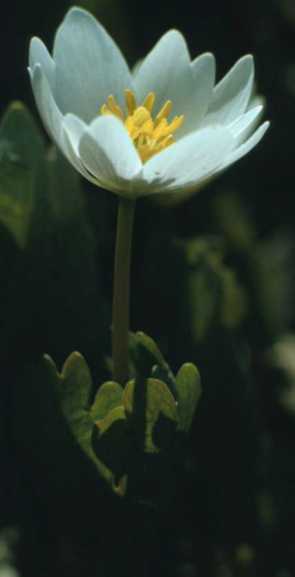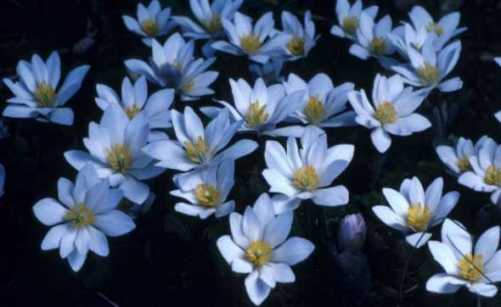
Sanguinaria canadensis (L)
Synonyms: Red Indian paint, red root, tetterwort, red pucoon, paucon, coon root, snakebite, sweet slumber
Order: Papaveraceae

Description: This small perennial plant has kidney-shaped leaves which arise directly from buds on the rootstock, with reticular veining and greyish-green downy surface; the single naked flower stem bears a white double flower. The rhizome is dark red in colour. Sanginaria grows in rich, open broad-leaved woodland through the eastern half of North America.
Parts used: rhizome and roots
Collection: The rhizomes are unearthed from May to June, or in the autumn after the leaves have dried.
Constituents: Isoquinoline alkaloids (sanguinarine, sanguidimerine, protopine, berberine, copticine, chelerythrine, homochelidine), red resin, starch, citric acid, malic acid
Actions: Strong expectorant, spasmolytic, emetic, cathartic, antiseptic, cardioactive, uterine stimulant, topical irritant, escharotic, antibacterial
Indications: Sub-acute or chronic bronchitis, asthma, croup, laryngitis, pharyngitis, deficient capillary circulation, and as a snuff for nasal polyps.
Therapeutics and Pharmacology: Sanguinaria is used primarily in the treatment of respiratory tract infections, particularly in debilitated and cold conditions. Although a stimulating emetic and expectorant, it has a relaxing action on the bronchial muscles and is of benefit in asthma, croup, and laryngitis. It works as a stimulant in cases of poor peripheral circulation. It be used as a snuff for nasal polyps, and may be applied to local inflammations and infections of the skin such as warts. The extracted alkaloid sanguinarine is employed as an anti-plaque agent in toothpastes and mouthwashes and it may also have an anti-cancer action.
Combinations: Combines with Lobelia in bronchitic asthma. May be combined with Salvia and Capsicum as a gargle in pharyngitis. Can be combined with Chelidonium as a topical application to warts and with Ulmus in chilblains.
Caution: Sanguinaria is poisonous in large doses and must never be used during pregnancy or lactation. It should only ever be taken under the supervision of a qualified practitioner.

Preparation and Dosage: (thrice daily)
GSL
Dried rhizome: 0.06-0.5g; emetic dose, 1-2g
Liquid Extract: 1:1 in 60% alcohol, 0.06-0.3ml; emetic dose, 1-2ml
Tincture: 1:5 in 60% alcohol, 0.3-2ml; emetic dose, 2-8ml
Additional Comments: Both the Latin and common names of this herb refer to the strong red dye in its root, used by Native Americans as a body paint and fabric dye. Sanguinaria is used homoeopathically to treat migraine.
Bibliography
BHMA 1983 British Herbal Pharmacopoeia, BHMA, Bournemouth.
Grieve, M. 1931 A Modern Herbal, (ed. C.F. Leyel 1985), London.
Hoffmann, D. 1990 The New Holistic Herbal, Second Edition, Element, Shaftesbury.
Lust, J. 1990 The Herb Book, Bantam, London.
Mabey, R. (ed.) 1991 The Complete New Herbal, Penguin, London.
Mills, S.Y. 1993 The A-Z of Modern Herbalism, Diamond Books, London.
Ody, P. 1993 The Herb Society's Complete Medicinal Herbal, Dorling Kindersley, London.
Polunin, M. and Robbins, C. 1992 The Natural Pharmacy, Dorling Kindersley, London.
Wren, R.C. 1988 Potter's New Cyclopaedia of Botanical Drugs and Preparations, C.W.Daniel, Saffron Walden.










